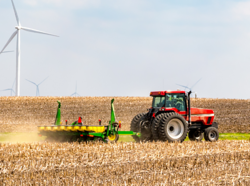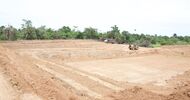Investigate Midwest | 21 September 2022
Foreign investors are snapping up US land … but exactly how much, who knows?
By Dave Dickey
Foreign investors are snapping up US land … but exactly how much, who knows?
By Dave Dickey
Anybody who has kept an eye on agricultural doings knows that consolidation is occurring at an alarming rate. In the past couple of decades, competition between agricultural giants has become a fading memory. Even this short list is staggering:
- China's WH Group purchased Smithfield Foods – the largest producer of U.S. pork – in 2013 for a steal-of-a-deal $4.7 billion.
- Brazilian meat-producer JBS purchased a majority stake in Pilgrim's Pride for $800 million in 2009.
- German pharmaceutical Bayer AG purchased St. Louis-based Monsanto for $63 billion in 2018.
-
ChemChina purchased Swiss-based seed and herbicide producer Syngenta for $43 billion in 2017. At the time, Syngenta owned a number of U.S. seed and chemical companies that accounted for roughly 6 percent of soybean seed sales and 10 percent of corn seed sales.
What do all these splashy headline acquisitions have in common? All are foreign acquisitions of U.S. companies. All well reported and documented.
It isn't just U.S. corporations that foreign companies are snapping up like Kmart Blue Light specials. Foreign acquisition of U.S. farmland has become big business. And the federal government's tally likely suffers from a huge undercount due to a joke of a law.
The Agriculture Foreign Investment Disclosure Act was passed in 1978 to keep track of foreign land acquisition of U.S. farmland. AFIDA requires:
- Foreign persons who acquire, transfer, or hold interests in agricultural land to report the transactions and holdings to the Secretary of Agriculture.
- USDA's Farm Service Agency to maintain for public inspection all reporting forms and related correspondence.
- Penalties to be assessed against foreign persons who fail to accurately and timely report.
- Foreign entities acquiring at least a 10% interest in U.S. agricultural land (defined as a minimum of 10 acres or land capable of producing annual revenue of $1,000 or more from farming) are required to file with USDA a FSA-153 form, which lists among other things the type of owners, total acreage, value of the land, and its geographical location.
Due to either neglect or intentional misdirection of filers, many records are inaccurate or incomplete.
USDA has no interest or desire to monitor what's going on. Back in 2017, AFIDA program manager Lesa Johnson made the stunning admission that USDA does not review FSA-153s for completeness or accuracy. Not much has changed since then.
In its latest 2020 report, FSA says foreign interests held an interest in 2.9% of all privately held U.S. agricultural land. That's 37.6 million acres, more than all the acres in the state of Iowa. Since 2015, foreign holdings have increased annually by an average of nearly 2.2 million acres.
And remember, the true numbers are likely higher – perhaps much higher.
Why should the public care about this?
The 2017 Census of Agriculture reported the average age of U.S. farmers was 57.5. That's almost 10 years older than reported in the 1945 Census. Meanwhile, it's become cost-prohibitive for many young people interested in farming to enter the industry. Not to mention that U.S. agricultural land slowly has been dwindling due in large part to industrialization and urbanization – from more than 1.15 billion acres in 1950 to 895 million acres in 2021.
So you have an aging farmer population that one day in the not-too-distant future will exit farming in droves and younger want-to-be-farmers unable to come up with the capital to buy farmland. The National Young Farmers Coalition is predicting two-thirds of all U.S. farmland will be on the auction block over the next decade.
Foreign entities are all too happy to take advantage of the opportunity … all under the less than watchful eye of USDA.
Admittedly, on a macro scale foreign U.S. land acquisitions do not currently threaten food security, which among our nation's families is primarily driven by poverty.
But what happens in the future if foreign investors continue to buy more farmland? Not to mention a bunch of other interests including U.S. corporation funds, pension funds, land development companies, and wealthy investors also wanting to own farmland.
The feds need to consider all these threats to long-term food security. And that starts with a full understanding of the scope of the problem including foreign land acquisition.
Efforts in the past to strengthen or rewrite AFIDA have gone nowhere in Congress.
Last month, Wisconsin Democrat Sen. Tammy Baldwin and Iowa Republican Sen. Chuck Grassley introduced the Farmland Security Act. The act would require USDA to report to Congress foreign investments of farm land, including analysis of the impact on food supply, rural communities and family farms. USDA also would be required to establish a real-time database as foreign farmland acquisitions are filed. While the bill is not perfect, passage would be a step in the right direction.
















